How much storage space is needed on your concession trailer? This is a question frequently overlooked by first time vendors. It’s easy to get wrapped up in the type of kitchen equipment that will be installed and the wrap of the vehicle. These are important parts of the build process. But at M&R Specialty Trailers and Trucks, we also understand you need to have enough available space on the concession trailer to store your raw materials like hamburgers, tacos, or BBQ after your equipment is installed.
Within the food industry, the amount of storage space inside your food trailer is referred to as your capacity. Your capacity will determine the maximum number of customers you can serve at any given event. As an example, if you were operating a taco truck that had available on board storage to make 500 taco plates. In this scenario, if you charge $8.00 per plate of tacos your maximum revenue per day would be $4,016. In this scenario, you would have plenty of storage and being able to serve 500 customers without needing to replenish the supplies on your trailer is a great situation to be in.

Another satisfied customer.
If you discovered, however that your maximum capacity of your vehicle was only 50 taco plates, you’ll be severely limiting your upside on the concession unit. In this hypothetical, you would hit a daily revenue ceiling of just $400. If you are a solo operator with a small trailer, you could still technically be turning a small profit with this level of capacity. But why put such a low cap on your potential sales?
In the example above, you’ll likely find that during busy time periods you’ll run out of food to serve and won’t be able to take advantage of demand. This is a missed opportunity as a business owner. This is not a good situation from a customer experience standpoint either. There’s nothing worse than waiting in line at a food trailer for 10 minutes only to find that they’ve run out of food once you get to the serving window.
How Much Capacity Do You Need?
Everyone’s storage capacity needs will be different. If you operate a coffee truck, it’s very likely you won’t need a whole lot of extra space because coffee beans, milk, cream, and small sides like pastries don’t require a whole lot of space. On the other hand if you’re operating a BBQ trailer that serves a variety of sandwiches and plates, you’re going to need room to store those smoked meats.
One good starting place for determining your trucks overall capacity is to calculate the break-even point for your truck. In other words, how many sales would you need per day to pay off all your expenses. After you determine the minimum sales needed to cover your operating costs like wages, gas, and cost-of-goods sold (COGs), you’ll be able to start playing around with the numbers to find out how much on-board storage you’ll need. Obviously, you want to do much better than breaking even on the concession trailer so make sure you create a maximum single day revenue goal that you would be happy with and go from there.
The formula for a break-even analysis is below:
Total Fixed Costs ÷ ( (Total Sales – Total Variable Costs) / Total Sales) = Break Even Point

M&R Specialty Trailers and Trucks Booth at the Florida Restaurant & Lodging Show
Quick Options For Increasing Capacity
Enlist help: If you need to restock your shelves in a pinch, having an employee or a family member that can travel off-site to get more supplies is a simple way to make sure you’ve got appropriate capacity at an event. If you have a runner, they are able to drive to the commissary, grocery store, or restaurant supply center to get more product is a simple way to ensure you’re able to maximize sales on your truck. Just make sure you’re not pulling employees from the serving window, which could reduce your throughput times.
Get a second vehicle: At a certain point, there’s only so much storage potential on a mobile concession unit. Another solution that’s been used by our customers is to get a second vehicle dedicated exclusively to food storage. Often a smaller unit like a van is sufficient for this purpose and the vehicle may have little more than some shelving and refrigeration units installed.
